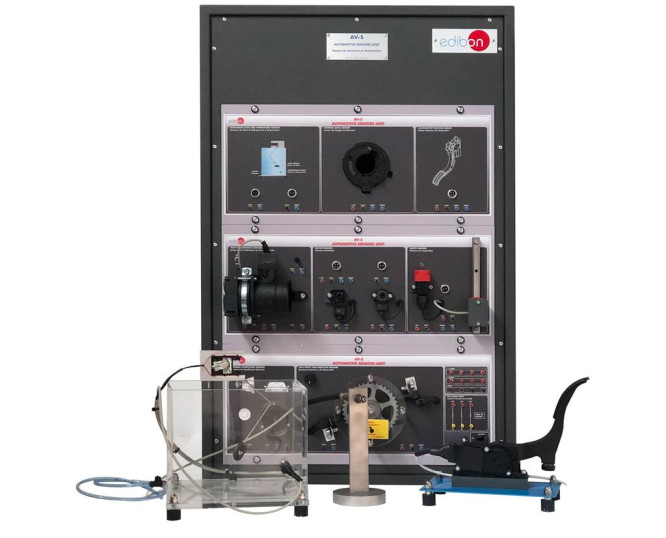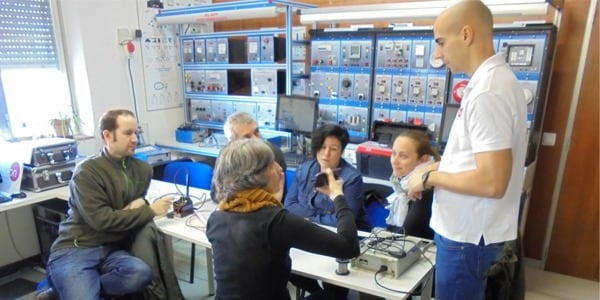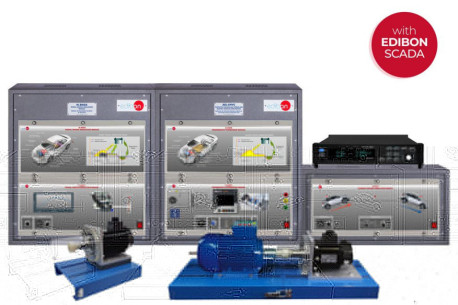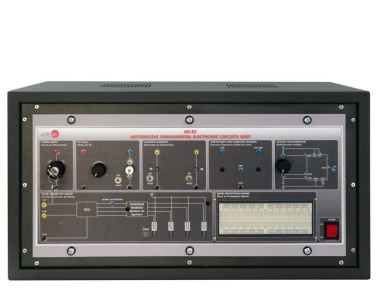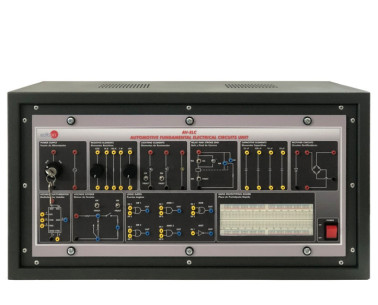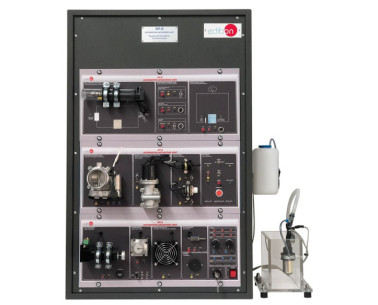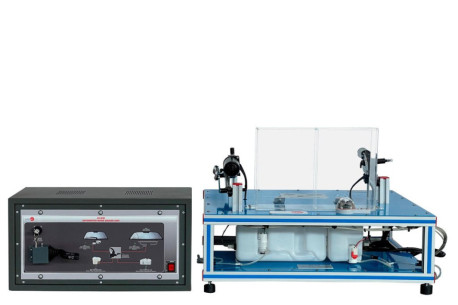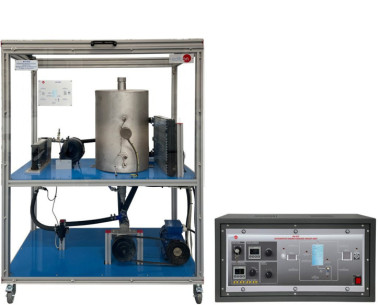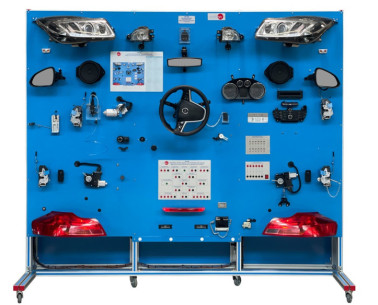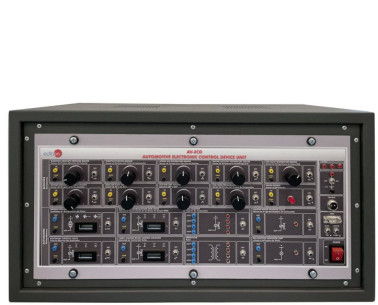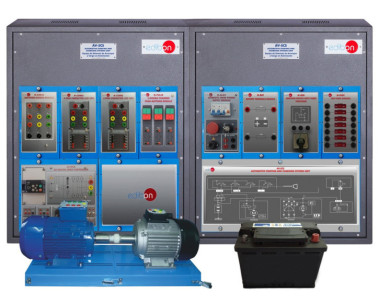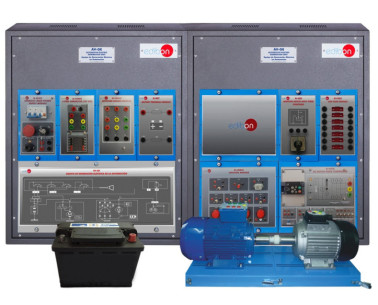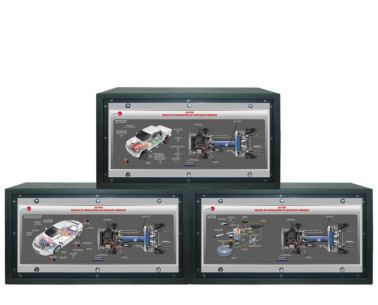On December 1st, the Repair Course for Small Laboratory Equipment, taught by our engineers at the EDIBON facilities, was completed, lasting 4 days.
The attendees, (Laboratory technicians and maintenance of the Rey Juan Carlos University of Madrid) had the opportunity to perform multiple...
AV-S 自動車センサーの装置
革新的なシステム
The Automotive Sensors Unit,"AV-S", has been designed by EDIBON to study the electronics componets and sensors used in the automotive.
関連ニュース
概要
The Automotive Sensors Unit, "AV-S", provides a practical solution to familiarize the students with the sensors used in modern automotive systems.
The Automotive Sensors Unit, "AV-S", is composed of real sensors and components used in current automotive systems. The "AV-S" unit is provided with a different set of practical exercises, through which the student will understand how the sensors of the automotive field work.
The sensors included in the "AV-S" are focused on the measurements required for the engine management system, being the mass air flow sensor, the Lambda sensor, different temperature sensor, oil pressure sensor, accelerator pedal position sensor, etc. but there are also other sensors for the stability system, the parking system, the lighting system and the safety system.
All sensor circuits included in the unit are isolated to understand the function of the circuits separately. All connector points of the sensors circuits are accessible through 2 mm standard lab sockets.
The "AV-S" can work alone, but some sensors can also be connected to the Automotive Electronic Control Device Unit, "AV-ECD", to send real sensors measurements to an electronic control unit.
The sensors of the "AV-S" unit are communicated through digital signals, analog signals, PWM signals and the network protocols CAN bus and LIN bus.
演習と指導の慣行
マニュアルに含まれるガイド付き実習
- Use of the crankshaft sensor to measure the phase of the crank.
- Use of the Hall effect camshaft sensor to measure the rpm of the engine.
- Accelerator pedal position sensor signal.
- Function of the refrigerant level switch.
- Manifold absolute pressure sensor signal.
- Function of the inertia switch in the safety system.
- Understanding the Lambda sensor reading.
- Calibration of an accelerator pedal position sensor signal.
- Understanding the knock sensor reading.
- Mass air flow sensor signal.
- Calibration of a throttle-valve potentiometer.
- Differences between the inlet air temperature sensor, refrigerant temperature sensor and outdoor temperature sensor.
- Function of the light intensity sensor signal.
- Understanding of the ultrasonic proximity sensor.
- Function of the transverse acceleration sensor signal in the electronic stability program, ESP.
- Understanding the steering angle sensor reading.
より実用的な練習をして、ユニットを完成させる
- Several other exercises can be done and designed by the user.
補完的な機器
2.5.- オートモーティブエレクトロニクス
AEL-EHVC
The Computer Controlled Hybrid and Electric Vehicles Application, "AEL-EHVC", is an application designed by EDIBON for the theoretical and practical training of the different topologies of electric/hybrid vehicles most used today.Given the...
2.5.- オートモーティブエレクトロニクス
AV-EC
自動車基本電子回路の装置
The Automotive Fundamental Electronic Circuits Unit, "AV-EC", provides a practical solution to the introduction of electronics in the automotive field with a group of common circuits used in the automobiles nowadays.The circuits included in the...
2.5.- オートモーティブエレクトロニクス
AV-ELC
自動車基本電気回路の装置
The Automotive Fundamental Electrical Circuits Unit, "AV-ELC", provides a practical solution to the introduction of electricity in the automotive field with a group of common circuits used by the automobiles today.The circuits included in the...
2.5.- オートモーティブエレクトロニクス
AV-A
自動車駆動装置の装置
The Automotive Actuators Unit, "AV-A", provides a practical solution to become familiar with the actuators used in today’s automobiles.The Automotive Actuators Unit, "AV-A", is composed by real actuators and components used in present automotive...
2.5.- オートモーティブエレクトロニクス
AV-WW
自動車ワイパーの装置
The Automotive Wiper Washer Unit, "AV-WW", provides a practical solution to the introduction of the components of the wiper washer system used in the automotive field nowadays.The components included in the "AV-WW" are focused on different...
2.5.- オートモーティブエレクトロニクス
AV-ECC
自動車エンジン冷却回路の装置
The Automotive Engine Cooling Circuit Unit, "AV-ECC", provides a practical solution to the introduction of the engine cooling systems electronics used in the automotive field nowadays.The components included in the "AV-ECC" are focused on...
2.5.- オートモーティブエレクトロニクス
AV-AC
自動車補助部品の装置
The Automotive Auxiliary Components Unit, "AV-AC", provides a practical solution to obtain advance knowledge in the electronic and electric systems used in the automotive field today.All sensors and actuators included in the "AV-AC" unit are...
2.5.- オートモーティブエレクトロニクス
AV-ECD
自動車用電子制御装置
The Automotive Electronic Control Device Unit, "AV-ECD", provides a practical solution to the introduction of electronic control units or ECUs.The Automotive Electronic Control Device Unit, "AV-ECD", is composed of an Electronic Control Unit (ECU)...
2.5.- オートモーティブエレクトロニクス
AV-SCS
自動車の始動と充電システムの装置
The Automotive Starting and Charging Systems unit, "AV-SCS", has been designed by EDIBON to provide theoretical and practical trainingin the field of electrical starting and charging systems for motor vehicles. This unit aims to provide students...
2.5.- オートモーティブエレクトロニクス
AV-GE
自動車発電装置
The Automotive Electric Generation Unit, "AV-GE", provides a practical solution to help to become familiar with the components used intoday’s automobile electrical circuits.The components included in "AV-GE" focus on the generation of electrical...
2.5.- オートモーティブエレクトロニクス
AV-HYB
コンピュータ(PC)から制御されるハイブリッド車両シミュレーション装置
The Computer Controlled Automotive Hybrid Simulation Unit, "AV-HYB", has been designed by EDIBON to study and analyze the operationof the hybrid vehicle through the different forms of combination of the energy sources it uses. For this purpose,...
品質

アフターサービス

 クッキーの設定
クッキーの設定

